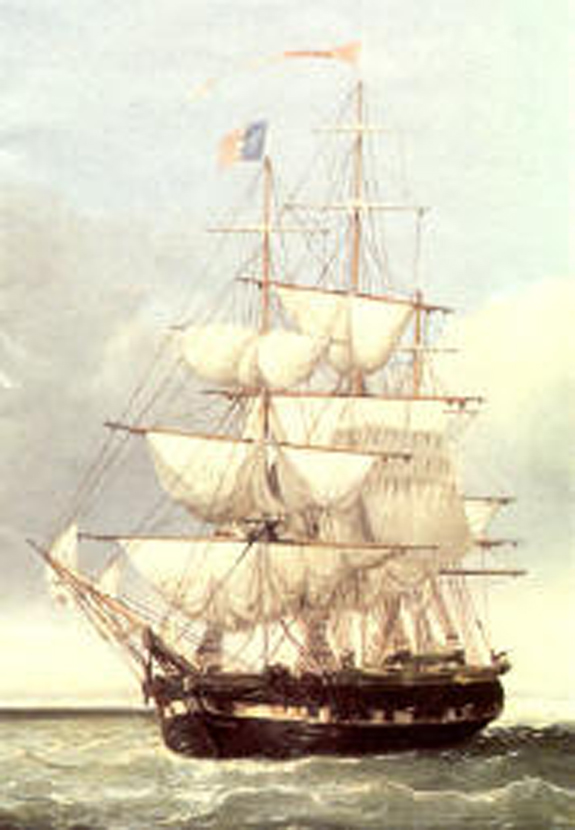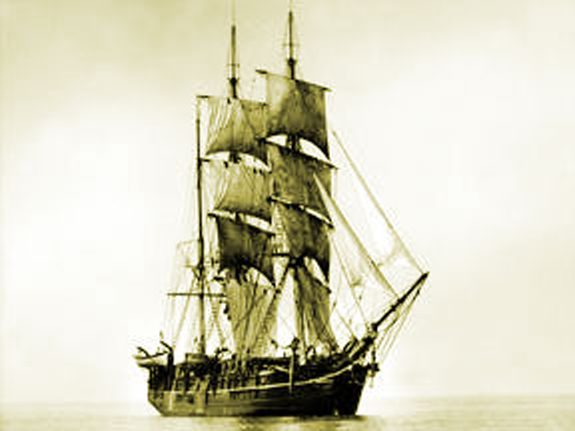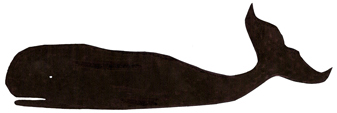Local New Bedford, Ma. History
1830 - 1839 In Chronological Order
Scroll Down
|
 |
| |
1830
County Road became County Street in this year.
|
The Portuguese immigration to New Bedford was increasing.
|
1830 June 30,
A town meeting was held, and a vigilance committee was appointed to ensure that riotous mobs did not destroy any more property as had been the case with the two incidents of the Ark's (See 1826 and 1829) and the "Hard Dig" neighborhood on Kempton Street.(August 1826).
This vigilance committee was later to evolve into the "Protecting Society" a part of the Fire Department. |
| |
1830 July 25,
The Second Great Fire.
The house of William H. Allen, on the southeast corner of School and Seventh Street, caught fire.
It was a Sunday morning after a long spell of dry weather and most people that could help were in church.
The house of Gideon Allen next door was almost immediately consumed..
A strong west wind blew a lot of cinders onto buildings as far as 3/4 of a mile.
Dudley Davenport's carpenter shop and Jethro Coffin's boat building shop "burned to the ground with the rapidity of magic". Read more about this and his second fire in 1848
Tilson B. Denham's barn and a quantity of oil owned by Abraham Barker and stored in the cellar of Mr. Davenport's shop were consumed.
Many other buildings were started to burn and stopped due to the diligence of the Fire Department and citizenry in general.
The efficacy of the newly organized protecting society was very strikingly shown on this occasion.
"Ladies were actually seen passing water and furnishing refreshments to the exhausted firemen".
|
| |
1830
At this time, there were 120 square rigged ships mostly in whaling. Ships brought in 44,144 barrels of sperm oil and 43,145 of whale oil that year.
There were 10 spermaceti candle manufacturers in the city. The population was 7,695.
|
| |
1830 April
Vigorous action is taken to restrict the sale of liquor.
At a town meting in April, resolutions were passed recommending the selectmen to limit the number of retail dealers to five, and "that they be qualified by their character for integrity, discretion and firmness faithfully to fulfill the important obligations that the law enjoins". |
| |
1830
At the annual Town meeting, the boundaries of streets and roads were fixed, and monuments level with the ground and made of granite were placed.
They were marked with drill holes or cross cut to mark the center of the intersection.
See the list of streets from 1830 |
| |
| The school appropriation for 1830 was $4,225.00 and was distributed through 6 districts, with a special appropriation of $300.00 for "colored" children. |
| |
1830 June 1
A stage route between New Bedford and Padanaram was established.
The Siamese twins were first exhibited at the Mansion house, October 24.
October 28 - 29, the New England Caravan, gave an exhibition. |
| |
1830 - 1831
Construction is begun and completed on the Superior Court House on Court Street and County Street. |
|
1831
Benjamin Lindsey Jr. son of the publisher of the "The New Bedford Mercury" established the newspaper the "Daily Mercury" apparently just before and in the same year as his father's death. |
| |
1831
The streets were lighted with "Lanthorns" and $1,250.00 were appropriated for provision and maintenance.
March 28 First street is extended from Walnut to Bush Street.
The Double Bank Building was constructed on Water street at the foot of Wiliam. |
| |
1831
The Seaman's Bethel is built on Johnny Cake Hill across from the New Bedford Whaling Museum.
It was dedicated on May 2, 1832, and was made famous in Herman Melville's "Moby Dick.".
Herman had visited there before his whaling voyage.
Inside the chapel, there are 30 cenotaphs with the names of the whale men and fisherman who were lost at sea. It is still a functioning chapel and a favorite for weddings. |
| |
1832
Several reservoirs were built for a resource for the fire engines in case of fires.
In 1832, the streets and highways were improved, and the first flagged sidewalks were laid.
The road from Ricketton's house, near Clark's cove easterly and southerly, to the road leading to Clark's point was accepted.
Penny post delivery for mail was first inaugurated in New Bedford with Richard Williams as postmaster.
Two cents were charged for local mail.
The North Christian Church was raised in August in three days by twenty men, without the use of ardent spirits.
It was thought to be the largest place of worship in America at 90 feet length by 70 1/2 feet width and 145 feet to the top of the spire.
Albert Bierstadt who later became a famous painter arrived with his family from Germany to live in New Bedford.
The Seamans Bethel is dedicated by the New Bedford Port Society. |
| |
1833
The water closet (flush toilet) was invented. It's use of a lot of water, caused privy vaults and septic systems to overflow into the surrounding land causing a stench. |
| |
1833
Perry Russell's Prussian-blue works on the corner of William and Sixth street caught fire and burned down.
The house nearby was in danger of being burned so when the well had run dry the firemen used the blueing from a vat to spray on the fire.
The man's house was saved, but now it was painted a beautiful blue.
Sixth Street extended from Elm to Middle street accepted.
Maxfield street from Purchase to County Road (Street) and Mill street from Purchase to Ray street accepted. |
| |
1834
The street map was made.
November 18, 1834
There was a huge fire starting on Water Street that started at James Wady's shoe store.
Several buildings were entirely consumed despite the best efforts of the firemen and citizens.
A violent gale came from the east and extended the flames making the fire more ferocious.
A rain fall in the night greatly helped douse the fire. Several buildings were lost.
One anecdote is that the firemen were attempting to rescue a piano from a house, but the door was too narrow, so they decided to saw off the legs.
They didn't realize that the piano was made so that the legs easily screwed off.
June 25, 1834 An anti-slavery Society was formed at Lyceum Hall.
August 1
Became a black American and abolitionist holiday when Britain abolishes slavery in its colonies.
This year, John Howland Jr., built a brick mansion on 38 South Sixth Street. (It burned in 2005)
See photos here
|
| |
1834
The new Unitarian church was built made of stone and dedicated May 24, 1834. This left the old wooded building, built in 1795 - 97, to become Liberty Hall, after being sold in 1841 and refitted as a theater in 1846.
It was the site of many orations, performances and meetings despite the conservative Quakers staunch resistance to anything remotely theatrical.
Construction began on the United States Custom House on North Second and William Street. |
| |
1835
For several years prior to 1835 the sentiment of the city towards the circus was reflected in the actions of the selectmen refusing to grant licenses to the circuses.
The circus managers got around the issue by holding the events just over the line in Dartmouth.
Finally the selectmen of New Bedford decided to allow it, and the result was two weeks of circus entertainment by the Buckley, Weeks & Co. circus following December 23, 1835 at the amphitheater on the corner of County and Elm Streets.
The New York Zoological Exhibition and Columbian Circus performed for five days and had with them "Bolivar" possibly the first Elephant to be exhibited in this vicinity. |
| |
1835
Henrietta Howland "Hetty" Green was born (1835 -1916). She became to be known as the "Witch of Wall Street" and once was considered the wealthiest woman in the world.
She was extremely miserly.
Her son, Colonel Edward Green, who lost a leg as a child because his mother was too cheap to have it cared for by professional doctors, apparently dedicated his life to spending and giving away every last cent of his inheritance.
A good book about her and her son was written, entitled "The Day They Shook The Plum Tree". |
| |
1836
The first full and official city directory is published by Henry H. Crapo.
Crapo had served as a public official for a long time but then moved on to become the governor of Michigan.
The
population of New Bedford reaches 11,113, a forty-seven per cent increase in six years.
Temperance leaders noted that the city had 50 grog shops. |
| |
1836
Fourth of July as every other Fourth of July in the city was a big deal. This time it was with the revenue cutter McLane firing a salute early in the morning.
A lot of the area was brightly decorated with buntings and flags.
A procession started at 10:30 AM under the direction of Lieutenant Hodges and marched through several streets. An oration was given by Wendell Phillips.
In the evening, the cutter McLane was brightly illuminated at anchor just abreast of Union Street.
|
| |
1836
The Local Customs House - Post Office facing Pleasant and with Elm on one side and Middle on the other and backed by 6th street was built in 1836 of local cut granite and cost $31,740.00 including the land. Today it is the Main Post Office. |
| |
1836 August 1
The circus on Elm and County street formerly operated by Mr. Hians had become "The Lion Theater" and the play "Castle Spectre" was performed. The theater ran some Shakespeare plays "Richard lll" and Othello at different times but on March 28, 1837, the selectmen created trouble with the licence and it had to close for 10 days.
There were conservative Quaker influences that never stopped being an issue for any kind of performance in the city and the conservative narrow mindedness pervaded the city government, as well.
On September 14, 1840, after a town meeting, the citizens voted to reject any theatrical licence by a vote of 12 in favor and 566 against any performances in a theater.
|
| |
1837
Frederick Douglas a runaway slave travels to New Bedford.
He got help getting to the city by two of New Bedford's foremost citizens Joseph Rickettson and William C. Taber.
He was a monumental figure in the abolitionist movement.
The Young Men's anti-slavery Society held it's first meeting on January 2, 1837 in the building formerly known as the Elm Street Academy. |
| |
1837
Liberty Hall came into being in the old meeting house of the Unitarian Society at the corner of Purchase and WIlliam Street.
It was for many years the best and most patronized hall in the city. It was burned on the morning of February 10, 1864. A new Liberty Hall was built on the site and was used for lectures, public meetings, concerts, theatricals and various forms of entertainment for many years. |
| |
1837
Rural cemetery is opened covering an area of about 100 acres. The land was purchased by Timothy Dyer. He cleared off stone and made the first pathways.
It was later sold and then purchased by the city in 1849 for about $5,000.00.
In 1868, an additional 70 acres of land were purchased. When water was introduced pipes were brought into the cemetery, as well. In 1890 lots sold for as high as $2,345.00.
The current address of the main entrance and office is 149 Dartmouth Street.
Many famous people are buried there such as Charles Ashley a former mayor, Albert Pinkham Ryder a famous artist, Albert Bierstadt, another world famous artist, W.Garret Cherry founder of Cherry and Webb.
There is also a lifelike monument of Albert Zettick a taylor. |
| |
1838
Subscription books for the building of the first railroad to run from New Bedford opened on April 30, 1838.
The Unitarian Church on Union and Eighth Street was dedicated on May 23, 1838 construction began in 1837, and it was built at a cost of $40,000.00 including land.
In this year, a short section of South Water street was paved, as an experiment to test the method of improving highways. It was successful and was approved by the citizens.
|
| |
1838 - 1839
The City hall was built of native granite and cost, inclusive of land $60,000.00.
This building in 1910 would become the free public library after the 1906 fire burned the interior.
In 1906 after the fire City Hall offices moved into the brick building of the library building on 133 William St.
The library is as of 1910 in the renovated city hall building on the corner of William and faces Pleasant Street.. (southwest corner). If it all sounds confusing, that is because it is.
See events of 1906, 1910, 1856
|
| |
1839
The street improvement work was extended, and South Water street to School Street, and Purchase street from William to Union were paved.
The Pacific Insurance Company was organized on February 19, 1939 with a group of stockholders. |
The harbor was first dredged by the Army Corps of Engineers to improve access to the docks. |
| |
| There were 177 ships in New Bedford's fleet |
| |
1839 - 1840
Smallpox made another appearance and strict rules were enforced.
One read "Every person, without any exception, who shall leave your premises, shall be thoroughly smoked by you before so doing."
General vaccination was enforced. |
| |
 |

